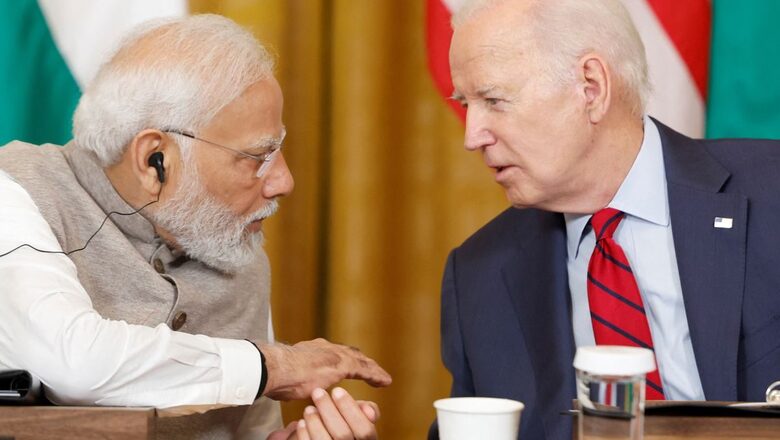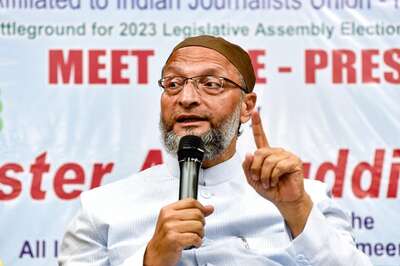
views
Considered to be the most ambitious joint statement in 75 years of diplomatic ties between Washington and New Delhi, it opens with Prime Minister Narendra Modi and President Joe Biden affirming the bilateral relationship as among the closest in the world – a partnership of democracies looking into the 21st century with hope, ambition and confidence.
This has acted as a springboard for the entire document, which comprises fifty-eight pointers and six sub-themes. It covers several areas from critical minerals to critical and emerging technologies, trade and telecommunication, transfer of technology to terrorism, nuclear to neutrino facility, stability in Afghanistan to cooperation in artificial intelligence, supporting reformed multilateralism to reaffirming faith in Indo-Pacific Economic Framework (IPEF), and much more.
The visit has come at the right time when there are parleys about America’s relative decline in the global order. On the other hand, India’s rising stature, economically and diplomatically, especially after the pandemic has picked up pace.
As much as India needs the US to enhance its external and internal balancing against the rising ambitions of China across the Indo-Pacific Region (IPR), Washington too needs a democratic counterweight to autocratic Beijing. The microcosm of what the oldest and the largest democracy can do to shape the order of things in the new world order is mirrored in the joint announcement.
China has been rattled by Prime Minister Modi’s visit, which can be captured in the words of foreign minister Wang Yi asking India to abandon the selfish game of the US in the light of increasing trade and technology interaction. In this context, here are some important takeaways from the statement.
First, the statement is full of symbolism and substance. It is a precursor to the reiteration and reaffirmation of de-risking and not decoupling from China, and the larger role that India will play in it. During the Covid-19 pandemic, the world was forced to choose between ‘with China or without it’, necessitating the need to build resilient supply chains. The coming together of India and the US in this context opens a new chapter in their bilateral ties and casts a long shadow in their togetherness based on shared values and ideas. Featuring semiconductor supply chain and innovation partnership, a resilient supply chain in telecommunications and development in 5G/6G technologies, strengthening of the pharmaceutical supply chain, cooperation in quantum computing, and AI is a mirror to that.
Second, the private sector will take the relationship by its horns. From the list of invitees who attended the official dinner in the White House to the specific mention of the big firms in the joint statement is a clear reflection of this. It hints towards the more broad-based agenda on which the relationship will be taken forward. For instance, the semiconductor giant Micron will invest a combined $2.7 billion in Gujarat to build an assembly and test facility in India. Applied Materials Inc will be investing $400 million to establish a collaborative engineering facility.
Third, it takes the relationship from archaic buyer-to-seller ties to facilitating greater technology transfer, with a focus on co-production and co-development. The landmark deal signed between General Electric and Hindustan Aeronautics Limited (HAL) for manufacturing GE F-414 jet engines in India is a testimony to this. Apart from the US, only Russia, UK, and France have this facility to manufacture the engine that can power combat aircraft. The coming of technology to India will unlock several doors of future collaboration, and further take the defence relations between the two democracies to the zenith.
Fourth, to further the multifariousness of the defence relation, private sector collaboration in this domain is something to watch out for. Atul Keshap, president of the US-India Business Council, posited: “This is a new era and we have to break down barriers and build meaningful ties and defence cooperation.” The progress can already be seen with the formation of the India-US Defence Acceleration Ecosystem (INDUS-X), the spadework of which was done during the visit of US defence secretary Lloyd Austin.
Fifth, the India-US ties are truly multifaceted and multidimensional with issues spreading across all the domains and sectors. There has hardly been any partnership that enjoys such wide grounds of convergence. The joint statement has also expanded cooperation to new arenas like dealing with illegal drugs; collaboration in the health sector like the use of traditional medicine; recognising the role of micro, small, and medium-sized enterprises; strengthening multilateral development bank (this must be noted with the recent talks about the de-dollarisation by several countries); and digital public infrastructure.
Last, but not the least, both India and the US agreed on reformed multilateralism with a special focus on the former’s permanent membership in the UNSC and the Nuclear Suppliers’ Group is testimony to India’s interest taking centre-stage among US policymakers. India has long demanded that the institutions of the 20th century do not respond and reflect the needs of the 21st century and, hence, require a major overhaul regarding their representation and objectives.
With the US coming out officially to support India’s candidature at these organisations, it will not be an easy journey for both given China’s strong opposition to the same. How the two will navigate these tumultuous times will serve as a true example of multilateralism for the world to witness.
India and the US have travelled a long distance from the era of sanctions to the complementary synergy witnessed today. The growing profile of the relationship reflects a partnership that is germane to finding solutions to all military and non-military issues undercutting this phase of dynamism in international affairs. The world today is neither multipolar nor bipolar or unipolar. As the world hangs in limbo, it opens an opportunity for New Delhi and Washington to shape things in an emerging new world order.
(The author is research associate, Centre for Air Power Studies. Views expressed are personal)














Comments
0 comment